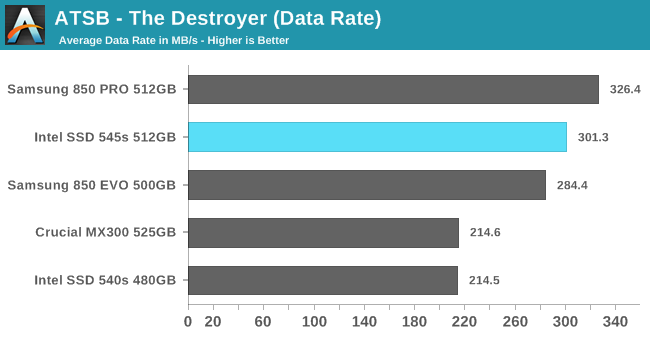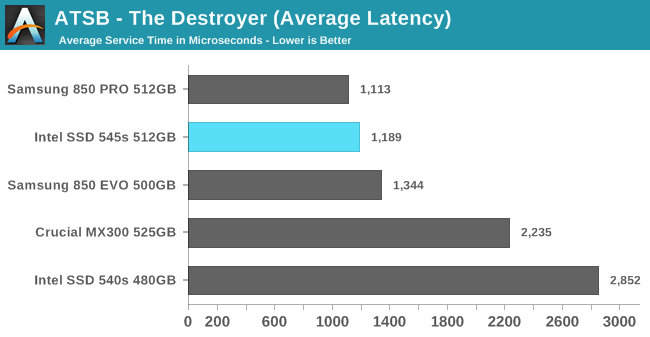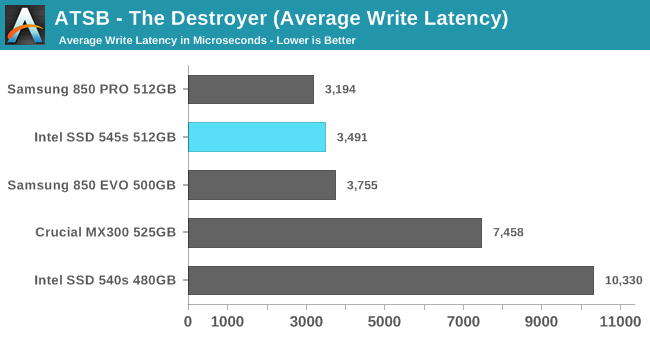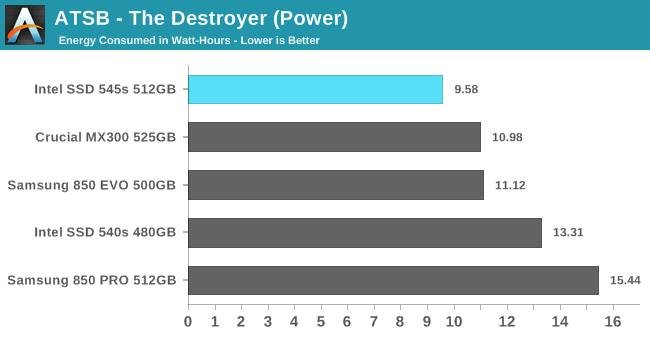The Intel SSD 545s (512GB) Review: 64-Layer 3D TLC NAND Hits Retail
by Billy Tallis on June 27, 2017 6:00 AM ESTAnandTech Storage Bench - The Destroyer
The Destroyer is an extremely long test replicating the access patterns of very IO-intensive desktop usage. A detailed breakdown can be found in this article. Like real-world usage, the drives do get the occasional break that allows for some background garbage collection and flushing caches, but those idle times are limited to 25ms so that it doesn't take all week to run the test. These AnandTech Storage Bench (ATSB) tests do not involve running the actual applications that generated the workloads, so the scores are relatively insensitive to changes in CPU performance and RAM from our new testbed, but the jump to a newer version of Windows and the newer storage drivers can have an impact.
We quantify performance on this test by reporting the drive's average data throughput, the average latency of the I/O operations, and the total energy used by the drive over the course of the test.

The Intel SSD 545s performs surprisingly well on The Destroyer, with an average data rate that surpasses the Samsung 850 EVO and potentially makes the 545s the new fastest SATA SSD with 3D NAND. The 3D MLC-based Samsung 850 PRO is still out of reach, but the 545s is a big improvement over the 540s and the Crucial MX300.

The Intel 545s also ranks between the Samsung 850 PRO and 850 EVO in terms of average latency, with slightly more than half the latency of the Crucial MX300 and an even wider margin over the Intel 540s.


Separating the latency according to reads and writes, we see that the 545s is much closer to the Samsung 850 PRO than the 850 EVO for reads. The write latencies of the Samsung drives and the 545s are all much lower than the Crucial MX300 or Intel 540s.

In addition to delivering great performance for a SATA TLC SSD, the Intel 545s brings a huge improvement in power efficiency. The 545s uses 12% less energy than the Crucial MX300 or Samsung 850 EVO over the course of the test. Only a few SSDs have ever completed The Destroyer on such a small energy budget, and only one other TLC SSD has been this efficient.










74 Comments
View All Comments
woggs - Tuesday, June 27, 2017 - link
Once a nand factory is running on a new generation, it has to sell components. The only path out the door for nand is an SSD (for Intel). A product like this gets out quicker and starts the flow. Not a big money maker but gets the factory running in it's early stages.nevcairiel - Tuesday, June 27, 2017 - link
I hope 64-layer TLC brings us closer to more affordable consumer "mass storage" SSDs. I would love to replace my 3TB storage spinning drive with a SSD, but I would need at least that space again - and right now thats still very expensive.MajGenRelativity - Tuesday, June 27, 2017 - link
That is definitely needed. SSD prices need to continue to decline in order to finally finish off HDD's once and for allHomeworldFound - Tuesday, June 27, 2017 - link
That's going to be a slow process, one the mechanical storage companies are going to want to slow down even further.mkozakewich - Wednesday, June 28, 2017 - link
Why not a 6TB HDD?Mechanical drives look like they'll keep their edge on raw capacity for the foreseeable future. You're best off with a dual system.
Drumsticks - Tuesday, June 27, 2017 - link
The SSD 540 was a disappointing product that honestly should have pretty much never been released. It sucked. This one is much better! It's not the best, but it's certainly competitive, and that performance on the destroyer looks great. Kudos to Intel.We just need the price to go down. I bought a 512GB Crucial MX100 years ago for $163 on sale. It's crazy how high prices have gotten recently.
mkozakewich - Wednesday, June 28, 2017 - link
Ha, I remember just a few years ago when the prices were hovering around $1/GB! It kind of feels weird to hear people complaining about high prices at 30-40¢/GB.Remember the Intel X25-M in 2009 for over $500? For 60 GB? AnandTech covered that by benchmarking application start times compared to HDDs. There was this whole problem with janky SSDs, so they described the problem and ran tests on those other low-end SSDs.
We've come so far!
eddieobscurant - Tuesday, June 27, 2017 - link
The bapco benchmark is useless. The differences are negligible . Please don't include it in the new 2017 benchmark suite.lilmoe - Tuesday, June 27, 2017 - link
Totally disappointed. This just gets a tiny bit closer to the 850 EVO, yet it's a bit more expensive ($20 more for 512GB drives).I was hoping Samsung would be under real pressure to lower prices, but this just makes the 850 EVO seem a bit more competitive; it's a bit cheaper, proven for a while to be reliable (ie: a safer bet), and supports more features like encryption.
Seriously, are they even trying? Hoping some REAL competition is on the way shortly from the others...
I smell price fixing shenanigans.
Impulses - Tuesday, June 27, 2017 - link
It's kind of startling how long the 850 EVO has dominated for... It launched at the end of 2014, over 2.5yrs ago now, and pricing has remained more or less constant for the last 2 years (at least for the 1TB I've bought, same today as in the summer of 2015).When has a single storage product ever had that long of a run without a serious challenger? Even Samsung decided to ride it after quickly iterating (and suffering some issues along the way) thru the 430 - 830 - 840.